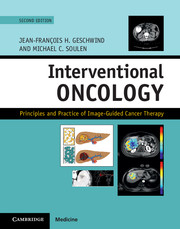Book contents
- Frontmatter
- Contents
- List of contributors
- Section I Principles of oncology
- Section II Principles of image-guided therapies
- Section III Organ-specific cancers – primary liver cancers
- Section IV Organ-specific cancers – liver metastases
- Section V Organ-specific cancers – extrahepatic biliary cancer
- Section VI Organ-specific cancers – renal cell carcinoma
- Section VII Organ-specific cancers – chest
- Section VIII Organ-specific cancers – musculoskeletal
- 25 Percutaneous ablation of painful metastases involving bone
- 26 Cementoplasty and musculoskeletal interventions
- Section IX Organ-specific cancers – prostate
- Section X Specialized interventional techniques in cancer care
- Index
- References
25 - Percutaneous ablation of painful metastases involving bone
from Section VIII - Organ-specific cancers – musculoskeletal
Published online by Cambridge University Press: 05 September 2016
- Frontmatter
- Contents
- List of contributors
- Section I Principles of oncology
- Section II Principles of image-guided therapies
- Section III Organ-specific cancers – primary liver cancers
- Section IV Organ-specific cancers – liver metastases
- Section V Organ-specific cancers – extrahepatic biliary cancer
- Section VI Organ-specific cancers – renal cell carcinoma
- Section VII Organ-specific cancers – chest
- Section VIII Organ-specific cancers – musculoskeletal
- 25 Percutaneous ablation of painful metastases involving bone
- 26 Cementoplasty and musculoskeletal interventions
- Section IX Organ-specific cancers – prostate
- Section X Specialized interventional techniques in cancer care
- Index
- References
Summary
Introduction
Skeletal metastases are common in patients with cancer and often impact a patient's quality of life due to focal pain, frequent fractures, and resultant decreased mobility. Approximately 70% of the 1 million people who die in the United States each year have breast, lung, or prostate cancer and approximately one-half of these, or 350,000 people, will die with bone metastases. Although bone metastases indicate a poor prognosis, with a median survival of 3 years or less, 5–40% of patients are alive at 5 years dependent on tumor histology and burden. Bone-related cancer pain is often undertreated, with nearly 80% of patients experiencing severe pain before a sufficient palliative treatment plan is initiated.
Management of patients with painful skeletal metastases is most effective through a multidisciplinary team that can offer optimal analgesic therapy, radiation therapy, surgery, hormonal and chemotherapies, and focal image-guided ablation therapies. The standard of care for treatment of painful metastatic skeletal disease is external-beam radiation therapy (EBRT). This treatment is effective for 50–80% of patients and there is complete pain response in 50–60%. Although a majority of patients experience complete or partial relief of pain following radiation therapy, median relief of pain is achieved in 3–7 weeks and pain relief response is transient in greater than one-half of the patients. While radiation therapy results in an initial reduction in pain for the majority of patients, at least for a period of weeks, 20–30% of patients do not experience pain relief. Retreatment is possible for many patients but for patients who experience minimal or transient relief of pain following EBRT, further treatment is typically not offered or further radiation therapy may not be offered secondary to limitations in normal tissue tolerance.
Other treatment options for patients with painful skeletal metastases include surgery, which is generally reserved for lesions at great risk for fracture or for spinal metastases causing neurologic compromise, systemic therapies including chemotherapy, hormonal therapy, radiopharmaceuticals, and bisphosphonates in combination with opioid and non-steroidal analgesics. For most patients, pain due to metastatic skeletal disease is often refractory to standard chemotherapy or hormonal therapy.
- Type
- Chapter
- Information
- Interventional OncologyPrinciples and Practice of Image-Guided Cancer Therapy, pp. 243 - 254Publisher: Cambridge University PressPrint publication year: 2016



